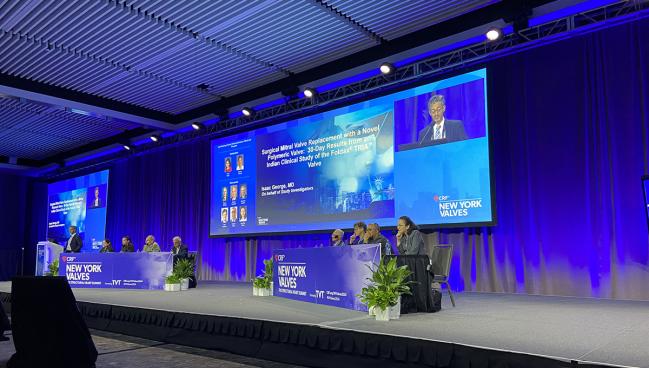Polymer Mitral Valve Shows Well Early, but Long-term Data Key
The surgical field is rich with nonmechanical valves that failed over time, leaving some surgeons cautious about early data.

NEW YORK, NY—A new mitral valve prosthesis—using a polymer designed to minimize the need for long-term anticoagulation—has demonstrated good hemodynamics at 30 days, with no signal of adverse clinical events.
Such a device, should it prove durable over years, might be particularly attractive to patients because it could overcome some of difficulties posed by mechanical valves, specifically the quality-of-life issues that arise from including the need for long-term oral anticoagulation. It might also be beneficial in parts of the world where access to devices and medications, coupled with rampant rheumatic disease, pose different challenges to care. Presenting the early findings for the Tria polymer valve (Foldax) last week at New York Valves 2024, surgeon Isaac George, MD (NewYork-Presbyterian/Columbia University Irving Medical Center, New York, NY), said the 30-day results are reassuring. “We're not seeing any major valve issues,” he reported.
Moreover, while warfarin was required by study protocol, only half of patients were successfully maintained within the required INR range, which makes the findings particularly intriguing, said George. “We will eventually transition people off warfarin, and we’ll have to see how that works, but the hope would be that we can go to a lower dose or completely off anticoagulation altogether.”
Polymer valves have been around since the 1950s, with a host of materials explored, including polyurethanes, polytetrafluoroethylene (PTFE), and more recently the incorporation of silicone-based derivatives. All materials to date have weathered a long history of difficulties, however, including mechanical degeneration, polymer breakdown, and thrombotic complications. But interest in polymers has persisted, because “it doesn’t form calcium for immunological reasons,” George explained. “That’s a huge advantage in young people where the immune response is so robust.”
Steven Bolling, MD (University of Michigan Medical Center, Ann Arbor), the discussant following the late-breaking presentation, agreed that an “artificial valve that lasts forever and doesn’t need anticoagulation has been the Holy Grail for cardiac surgeons.” He was uncertain, at least based on these early results, that this latest contender would be able to overcome the challenges posed by this anatomy.
Like George, Bolling said the concern with a polymer valve is not calcification, but resistance to tear and mechanical fatigue, which will take years to manifest as problems. Silicone polymer valves have tended to break down around 4 to 5 years, he noted, and these devices need to be handled with particular care.
“We do a lot of things that maybe we take for granted on the aortic and mitral side in terms of handling the valve tissue, and I think we have to be extremely careful doing that,” said Bolling.
Proprietary Polymer
The Tria valve uses a proprietary, non-animal-based polymer (LifePolymer) comprised of siloxane-based polyurethane urea. The three polymer leaflets are solution cast, not stitched, onto a polyether-ether-ketone stent with a PTFE sewing cuff using fully automated robotic manufacturing.
“It’s been extensively computationally designed for optimal hemodynamics and the lowest leaflet stress profile,” said George. The robot used in manufacturing is about the size of a small closet, but “in that area you can make one valve in an hour.” The advantage, added George, is that the automated robot can be placed in resource-deprived countries or areas. “I think it’s interesting in that regard,” he said. “It really allows for efficient, high-scale manufacturing at a much lower cost.”
At New York Valves, George presented 30-day clinical and echocardiographic outcomes for 67 prospective patients treated at eight Indian hospitals. All were deemed suitable candidates for surgical mitral valve replacement due to moderate-to-severe mitral valve stenosis, moderate-to-severe mitral regurgitation (MR), or moderate-to-severe mixed mitral stenosis/MR. Per study protocol, concomitant surgical procedures, aside from left atrial appendage closure, were not permitted.
All patients were started on warfarin after the procedure, with a planned duration of at least 12 months. After that, the decision to stop anticoagulation remained at the discretion of the site investigator based on information from transthoracic echocardiography, CT angiography, and lab work. Patients in the trial were young—mean age 42 years—and two-thirds were female. More than half had NYHA class III/IV heart failure symptoms, and nearly 75% had rheumatic heart disease.
The majority of patients received either a 25- or 27-mm valve, with the remaining 20% treated with either a 23-, 29-, or 31-mm valve.
At 30 days, there was one death (1.4%) due to intraoperative surgical complications (left ventricular wall tear) and one ischemic stroke that resolved with thrombolysis. There was also a single patient with major bleeding. Two patients (2.4%) were readmitted, one for the ischemic stroke that occurred at 13 days and one for pleural effusion. There were no reported cases of valve thrombosis. While patients were prescribed warfarin during this early period, only 50% were successfully maintained in the INR range of 2.0 to 3.0 in this period.
On echocardiography, mean gradients decreased from 9.5 mm Hg at baseline to 4.3 mm Hg at 30 days, while peak gradients declined from 19.8 mm Hg to 9.6 mm Hg. The effective orifice area (EOA) also increased. The changes in mean gradient and EOA were consistent across the different valve sizes. Sixty patients had no/trace paravalvular leak (PVL), two had mild PVL, and one patient had moderate PVL.
Goal Is to Get Off Warfarin
The study population deserves attention, George said, noting that they had young women walking miles to participating clinics, some of whom would not be able afford or access medication regimens over the long term.
“Just totally different scenarios than we’re used to,” he said. “Some of them were from urban areas, but a lot of them rural. They don't have money for Coumadin. With mechanical valves, they have major complications when they miss their medicine. From the patients to the internists to the cardiologists to the surgeons, this has been something they're fixated on, because it’s such a huge issue for them.”
In the study, 42% of participants had atrial fibrillation (AF), yet just half were on oral anticoagulation. Some of the patients treated with the valve have already stopped their anticoagulation, having passed the 12-month mark, said George.
Joanna Chikwe, MD (Cedars-Sinai Medical Center, Los Angeles, CA), who moderated the session, observed that the checkered history of polymer valves and the difficult informed-consent conversations those require, as well as the plethora of established alternatives, make it challenging to enroll patients in new device trials. At her center, surgeons were unable to enroll a single patient in a prior early feasibility study testing the Tria aortic valve.
Nonetheless, if the long-term data pan out, the polymeric valve could be a “potential game changer,” she said.
According to George, the company will be filing for approval with Indian regulators once they reach 1-year follow-up. He added that they plan to present 6-month data at TCT 2024, and that full follow-up with echocardiography and CT is planned for 2 to 5 years.
There are also plans for a US trial to support Food and Drug Administration approval in the United States.
Michael O’Riordan is the Managing Editor for TCTMD. He completed his undergraduate degrees at Queen’s University in Kingston, ON, and…
Read Full BioSources
George I. Surgical mitral valve replacement with a novel polymeric valve: 30-day results from an Indian clinical study of the Foldax TRIA valve. Presented at: New York Valves 2024. June 6, 2024. New York, NY.
Disclosures
- George reports grant/research support from Boston Scientific and consulting fees/honoraria from Zimmer Biomet, Atricure, Neurosurgery, Neptune Medical, Abbvie, Johnson & Johnson, Durvena, Boston Scientific, Edwards Lifesciences, Medtronic, Help-TheraX, 3ive, Encompass Medical, Summus Medical, Abbott SJM, BCI, and Xeltis, He reports holding stocks/options in Valcare Medical, Durvena, CardioMech, Vdyne, MitreMedical, MITRx, BCI, and Trisol Medical.
- Bolling reports royalties from Laminar.
- Chikwe reports no conflicts of interest.





Comments